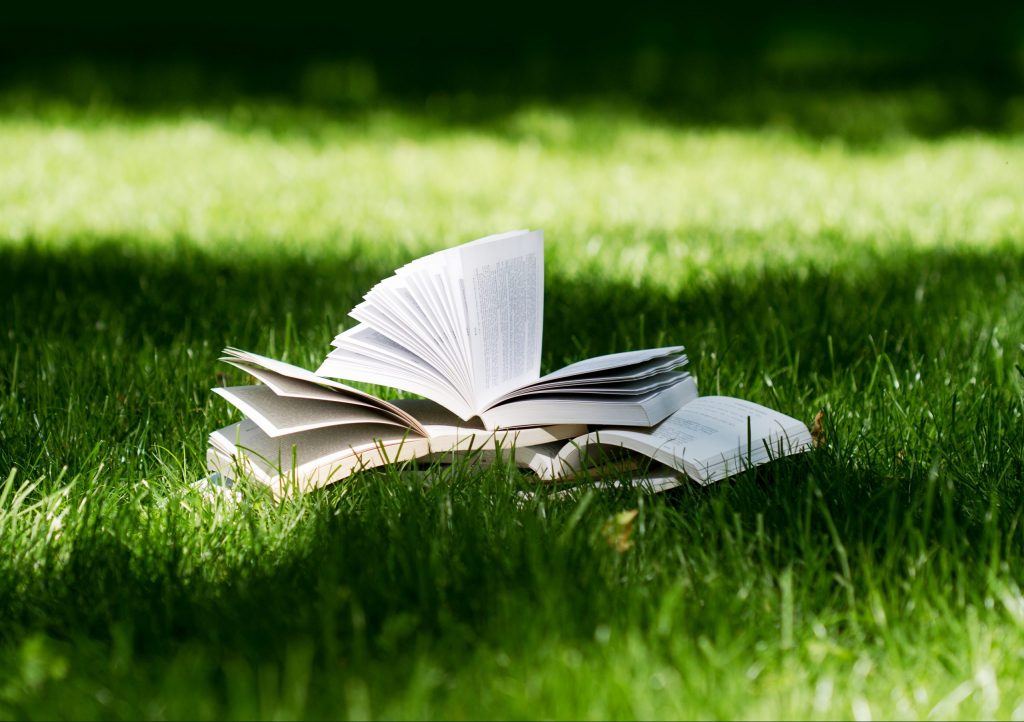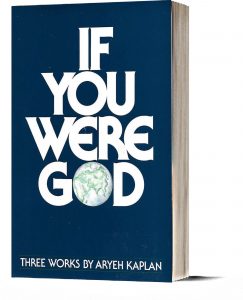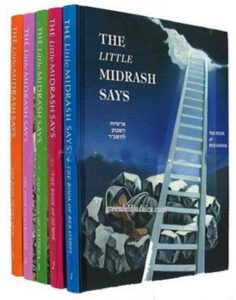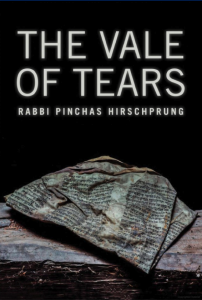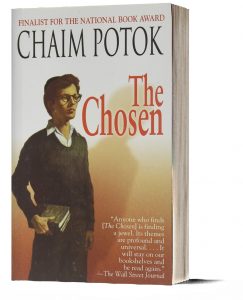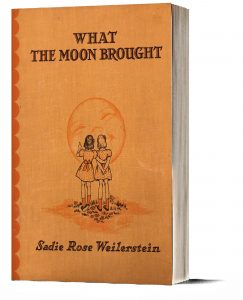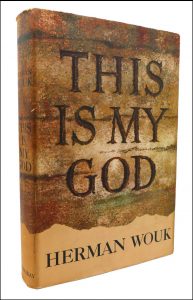Great Summer Reads
Facing a summer of social distancing after weeks of quarantining, many have turned to books and rediscovered the joy of reading. We asked Jewish Action readers to tell us about their favorite Jewish book—a book that changed their lives, strengthened their faith or helped them through a difficult time. See selected responses in the pages ahead.
Special thanks to Binyamin Ehrenkranz for helping to prepare this article for publication.
As a fifteen-year-old who attended public school and z, I read If You Were God by Rabbi Aryeh Kaplan, zt”l, in 1985. The book changed my life. It illustrated the framework of Yiddishkeit and what Hashem’s plan is [for the world], reinforcing much of what I had been learning at NCSY Shabbatonim. To this day I read it once a year.
Neil Harris is a former Midwest NCSY regional president (1988-89) and NY NCSY staff member. He lives with his wife and three children in Chicago, Illinois.
Before we are old enough for philosophy, heartfelt prayer, or even for the Talmud or the Mishnah, God places before our eyes a world of wonder and mystery, pregnant with as-yet-undiscovered meaning. There are many good stories out there, tales that beguile and delight, full of color and shade and people that seem real and alive.
Adult Jews today yearn for that Judaism of three dimensions, tangible and solid, the Judaism of the shtetl. But the Judaism of the shtetl was real not due to philosophy or the study of halachah or social circumstance alone. It was real because from the time they were children, our grandmothers and grandfathers lived with the rich stories bequeathed by our Sages, a non-abstract, childlike picture painted in rich hues, as far from the mud of Eastern Europe as can be imagined. This was the secret fire that once burned in every Jewish heart.
Our children can know these stories again from the age they can read or even before. They can be the students in yeshivah and seminary for whom new information is not a theoretical construct but a commentary on the real. That is, if they have read The Little Midrash Says, the greatest Jewish book in the English language.
Tzvi Kilov is a writer from Atlanta, Georgia. He received his treasured set of The Little Midrash Says from his grandmother, Zlatta bas Elchonon, of blessed memory, when he was five years old.
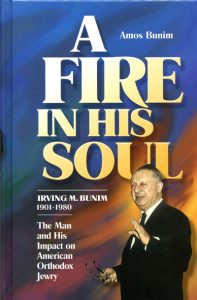 A Fire in His Soul: Irving M. Bunim, 1901-1980, The Man and His Impact on American Orthodox Jewry
A Fire in His Soul: Irving M. Bunim, 1901-1980, The Man and His Impact on American Orthodox Jewry
I grew up around Irving Bunim and knew the stories of his life. Yet reading his biography blew me away.
Irving Bunim negotiated fearlessly with the vicious Adolph Eichmann to smuggle out precious Jewish lives and save them from Auschwitz. In 1950, upon meeting a poor Sephardic immigrant child who could not read the Shema, his heart was broken, driving him to convince the avowedly secular first Israeli government led by Ben-Gurion to support an independent system of religious schools in Israel.
He helped build our Jewish day school system in the US ensuring the future of American Jewry. And he did the same for the Young Israel movement, making certain that we would have synagogues and communities to daven and live in.
He was a thoughtful scholar, steeped in Torah, who wrote profound and inspiring sefarim on ethics and Pirkei Avos.
In addition, he built a hugely successful business from scratch and was one of his day’s leading Jewish philanthropists.
He was humble, engaging, driven, determined, honest, capable, popular, funny, a speaker in great demand and a raconteur to boot. He famously hosted Rabbi Elchonon Wasserman, HaMakon yikom damo, and Ze’ev Jabotinsky in his home, albeit not on the same evening. His huge heart was open to the entire Jewish people.
He served as the right hand of my grandfather, the great Torah sage Rabbi Aaron Kotler, of blessed memory, in rebuilding the Jewish people after the Holocaust.
In light of such accomplishments, how could one not want at least a glimpse of such a magnificent, expansive life? If you want to laugh, cry, reflect and be inspired to act, you can—just by reading this book. In fact, though I have already read it many times, I plan to read it again.
Those who choose to join me will be astonished at how one man’s life could encompass so much.
Irving Bunim’s story is titled A Fire in His Soul—because that encapsulates what he possessed. How else could one human being have accomplished so much?
Rabbi Aaron Kotler is president and chief executive officer of Beth Medrash Govoha in Lakewood, New Jersey.
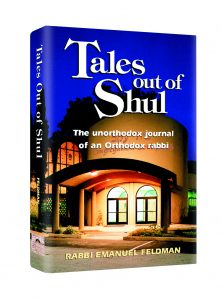 Tales Out of Shul: The Unorthodox Journal of an Orthodox Rabbi
Tales Out of Shul: The Unorthodox Journal of an Orthodox Rabbi
Some books influence your life. Others foretell it.
When twenty-four-year-old Rabbi Emanuel Feldman stepped off the train in 1952 in Atlanta, Georgia to lead Congregation Beth Jacob, he faced an Orthodoxy very much in retreat. His decades of service that followed both catalyzed and mirrored the dramatic growth of Torah observance in America that we recognize today.
In 1996, I was a high school senior deeply involved in NCSY and beginning to think about larger Jewish issues and my own future. It was then that I read the newly published Tales Out of Shul, Rabbi Feldman’s humorous but profound retrospective on forty years of rabbinic service in a very “out-of-town” milieu. His charming anecdotes—beginning with his eye-opening first she’eilah regarding the choice of a Hebrew name for a newly born “Nicholas” (spoiler alert: he chose Nechemia)—brought Jewish education and outreach alive for me. Scores of enlightening vignettes impressed upon me how one man can dedicate himself to the farthest reaches of the Jewish people and help transform generations.
A few years later, as a student at Ner Yisroel, I had the chance to meet the legend in person. I learned that he and I may have been the only two students in the yeshivah’s history to attend the same writing program at Johns Hopkins University—only fifty years apart! I was then on the cusp of beginning my own career, not as a pulpit rabbi but in outreach, navigating questions very similar to those Rabbi Feldman had encountered. In fact, I recently had the identical Nicholas name dilemma while leading an Israel trip!
Fast-forward another twenty years. I host a weekly podcast interviewing substantive personalities across the Jewish world. On an interview tour through the Holy Land, I found myself sitting in the rabbi’s dining room in Bayit Vegan. What an honor it was for me, deep into my own communal service career, to reflect with my early hero about his.
Several months after releasing the interview, I visited Congregation Beth Jacob, now led by Rabbi Emanuel’s son, Rabbi Ilan Feldman, and presented the lessons I had learned from their longtime leader. After delivering another talk in Charleston, South Carolina, in which I also mentioned the book, the shul’s rebbetzin approached me to share that she too had read Tales Out of Shul as a young girl and had been similarly inspired to become an out-of-town Jewish professional. She not only loved but ultimately “lived” the book as well.
Rabbi Ari Koretzky is executive director of MEOR Maryland, an outreach organization based at the University of Maryland, College Park and host of the podcast “Jews You Should Know.”
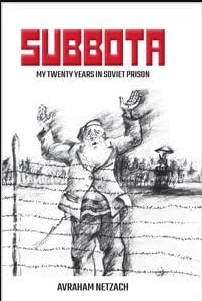 Subbota: My Twenty Years in Soviet Prisons
Subbota: My Twenty Years in Soviet Prisons
Back in the eighties, I borrowed the book Subbota from my neighbor in Givat Shaul.
Subbota (by Avraham Netzach, a pseudonym) is a true account of Rabbi Eliezer Nannes who was arrested and imprisoned in 1935 for counterrevolutionary activities (teaching and supporting Torah). He endured twenty years in a slave labor camp in Stalin Russia, during which time he managed to keep Shabbat, chagim and kashrut under the most outrageous and horrific circumstances.
Though written in a plain, un-schmaltzy style, the book reads like a spiritual thriller. Rabbi Nannes outsmarted the NKVD, outmaneuvered corrupt officials, gained the respect of the most brutal prisoners and influenced countless Jews toward Torah observance. (Subbota means Shabbat in Russian.) He managed to keep his beard too.
I basically read the book to its death (over the years the spine broke in several places and the pages scattered). After I finished the book the first time, I was shaking. “Who is this man?” I asked my neighbor. “Is he still alive? Can I meet him?” She brought me to his little apartment in an old Yerushalmi neighborhood. He was ninety, his wife ninety-six. They had no children. (By the time he got out of prison, it was too late.) The students to whom they taught Torah became their progeny. He was tough and funny with the kind of sheen on his face that holy people are often graced with.
Ruchama King Feuerman is a novelist and writing coach. She lives in Passaic, New Jersey, with her family.
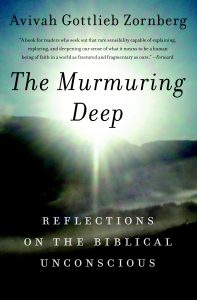 The Murmuring Deep: Reflections on the Biblical Unconscious
The Murmuring Deep: Reflections on the Biblical Unconscious
Back when Amazon was only a book vendor, the company name quickly became a verb in my family. Frequently I would hear from my father, “I read a book you might like; I’ll Amazon it to you.” That is how Dr. Avivah Gottlieb Zornberg’s Biblical interpretations captured not just my attention but also my imagination. As her books were arriving at my doorstep, I was acclimating to new roles: wife, mother, rebbetzin. Dr. Zornberg’s exploration of Biblical characters’ interactions with God, people and the world provided novel perspectives that appealed to me as I was confronting different life experiences, engaging with community members and trying to make sense of current events.
The ideas in her third book, The Murmuring Deep: Reflections on the Biblical Unconscious, have influenced my understanding of faith, personalities and relationships. For example, Dr. Zornberg’s discussion of Avraham’s drama at the Akeidah provides an interpretation of the shofar that affects the way I contemplate both historic and current Jewish events:
Abraham wants permanent credit for his silent restraint . . . the credit is to be transferred as prophylactic atonement for the sins of future generations. . . . Essentially, He [Hashem] denies Abraham the closure he asks for, the absolution that will inoculate his children against future sin, indeed, against the traumas of history. Instead, He refers him to the shofar as the means of evoking forgiveness. By blowing the shofar, future generations will continue Abraham’s work, rather than simply banking on it.1.
Dr. Zornberg’s descriptions of a human struggling to deal with trauma, couched within her interpretations of Yosef and his brothers, helped me better appreciate the psychological effects of trauma. She quotes the midrash about Yosef’s detour to the pit on his return to Egypt after burying his father. There she describes the experience of trying to heal from trauma: “he has gone to the trouble of returning to that place of his terror, in order to bring closure to the old narrative. He makes the blessing for a personal miracle, claiming the site of his trauma as the site of redemption . . . transforming pain into hope.”2
Tefillah, specifically the Maariv prayer, is explored through Yaakov, influencing me to think more deeply about the profound connection between each service and the Avot. Moreover, the events recorded in Sefer Bereishit provide fertile ground for Dr. Zornberg to explore spousal, sibling and parent-child relationships that impacted my own awareness of such interactions.
I am very grateful to Dr. Zornberg for enriching my life and sensitizing me to the murmurings of the deep.
Notes
1. Avivah Gottlieb Zornberg, The Murmuring Deep: Reflections on the Biblical Unconscious (New York, 2009), “Abraham Bound and Unbound,” 206.
2. Ibid., 319.
Nehama Teitelman is an administrator for research in the Department of Pediatrics at Albert Einstein College of Medicine and the rebbetzin of Young Israel of New Hyde Park.
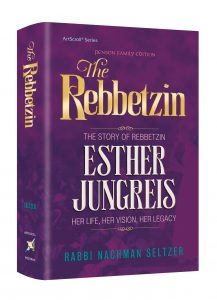 The Rebbetzin: The Story of Rebbetzin Esther Jungreis
The Rebbetzin: The Story of Rebbetzin Esther Jungreis
Since my teenage years, I have been on the lookout for appropriate mentors. Over the years I’ve been blessed with phenomenal women who inspire me and prod me to keep growing. I’m exceedingly grateful to them.
I recently read the impressive biography of Rebbetzin Esther Jungreis, a”h, skillfully written by Rabbi Nachman Seltzer. I had the privilege of knowing the Rebbetzin when I was a child in Camp Naarah. The talented Rebbetzin, who was in charge of shiurim at the camp, made a huge impression on me and I became friendly with the Rebbetzin’s oldest daughter. In 1973, together with my parents, z”l, I attended the life-altering event in Madison Square Garden where the Rebbetzin mesmerized thousands.
While I kept up with the Jungreis family over the years, I got busy with my own growing family (k”ah), and had no idea of the scope of the Rebbetzin’s reach. Now that I have read the book, I realize I have a new role model and mentor—the Rebbetzin!
The Rebbetzin was on a mission. A Holocaust survivor, she had witnessed the horrific loss of six million of our brethren. She could not tolerate further loss of our people to assimilation and intermarriage. With courage and determination, she used her enormous talents and energies to bring our people back. Traveling across the world to address audiences of all ages and backgrounds, she would engage her fellow travelers in conversation and impress upon them that they too had stood at Sinai and they too have an obligation to keep Torah and mitzvos.
Her devoted husband, Rav Meshulam Jungreis, z”l, supported and encouraged her. Her parents, who miraculously survived the camps together with her, were an incredible source of inspiration to her. In Bergen-Belsen, her father, affectionately referred to as “Zeide” throughout the book, gifted them with Shabbos. Zeide would save breadcrumbs for Shabbos, and say, “My precious lights, my beautiful kinderlach, close your eyes. We are home. Mama baked the most delicious challah . . .” Upon discovering how many family members he had lost in the Holocaust, Zeide cried out, “I beg of You Hashem . . . All my children . . . all Jewish children, should remain committed to Torah.” His devoted daughter Rebbetzin Esther took these words to heart, and ended up bringing thousands closer to Yiddishkeit.
Could I ask for a better mentor?
Miriam Liebermann, MSW, co-author of Saying Goodbye—A Handbook for Teens Dealing with Loss and Mourning, and editor of two anthologies for women, The Best is Yet to Be and To Fill the Sky with Stars, lives in Manhattan.
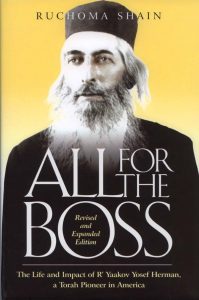 All for the Boss: The Life and Impact of R’ Yaakov Yosef Herman, a Torah Pioneer in America
All for the Boss: The Life and Impact of R’ Yaakov Yosef Herman, a Torah Pioneer in America
I was twelve when my mother handed me All for the Boss, Ruchoma Shain’s biography of her father, Rabbi Yaakov Yosef Herman, a passionate advocate for religious Judaism in early 20th century America. I was a compulsive reader as a child—which my parents sometimes indulged by letting me stay home from school to pore over novels such as Gone with the Wind or Exodus. Yet I had never read a book like this before. The stories about Rabbi Herman are remarkable, involving tremendous mesirut nefesh and generosity on his part, and also offer a fascinating window into a prewar Eastern European-influenced American Jewish milieu (with an equally fascinating excursus into Shain’s own time spent as a very American newlywed at the Mir yeshivah in Poland). Many of the stories are also ambiguous—such as the one where Rabbi Herman threw out of the house the secular novels that his bookish daughter treasured.
One story that stuck with me was when Rabbi Herman stormed into a crowded Young Israel synagogue one Friday night and banged on the pulpit, demanding they cancel an upcoming synagogue dance until he was physically dragged out of the sanctuary, his daughter watching the scene with mortification. Shain is able to animate what made her father remarkable without sugar-coating or even trying to resolve any of the complications. Subsequent rabbinic hagiographers should take note, although in many later biographies, one can also see Shain’s influence.
As a maturing child, I was enchanted by the stories about Rabbi Herman and also by the genre of book: one which seeks to use our contemporary qualities of description to capture a way of being that is not easily translated. Admittedly, All for the Boss did not convince me to return all of my secular books to the library, but it did ignite an admiration for a certain kind of unyielding religious passion, which stays with me even when I fall short. I believe the books (and films and music) that move us when we are young play a part in the development of our spiritual DNA as we get older. My “Boss” probably looks a little different than Rabbi Herman’s, but the book remains a touchstone for me in terms of what is possible for us to aspire toward as religious Jews.
Sarah Rindner is a writer and educator who recently made aliyah with her family.
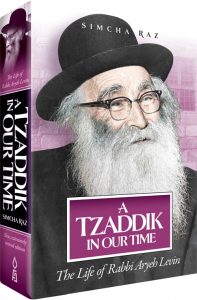 A Tzaddik in Our Time: The Life of Rabbi Aryeh Levin
A Tzaddik in Our Time: The Life of Rabbi Aryeh Levin
During the early days of my chrysalis several decades ago from a Jewishly ignorant secular Jew to a member of the Orthodox community who values time spent over a volume of Talmud or Chumash, I spent a Shabbos at the home of my employer, the publisher of Buffalo’s weekly Jewish newspaper where I worked as editor. On the long afternoon, with hours to spend between the last piece of kiddush kugel and the attempt to scrape together a minyan for Minchah, I came across a book on my host’s shelf that I had never seen before. It was the biography of a man that I, unfamiliar with the personalities of the Orthodox world, had never heard of—Rabbi Aryeh Levin.
A Tzaddik in Our Time by Simcha Raz, describes the life of the Jerusalem resident popularly known as the “Father of Prisoners,” an advocate of the incarcerated, the infirm, the outcast.
I picked up the book, all 550-or-so pages of it, settled into an overstuffed sofa in my host’s living room, and didn’t put it down until I finished reading every page.
Not only was the book fascinating, it was an education, an insight into a world and a worldview that I, a fledgling ba’al teshuvah, was just beginning to enter.
A Tzaddik in Our Time, in countless vignettes, taught me what it meant to be a frum Jew. Buffalo had a small Orthodox community, and I had few role models among the city’s small number of Orthodox synagogues and educational institutions. I had not yet traveled to New York City’s Orthodox neighborhoods, where I eventually made my home.
I picked up the book, all 550-or-so pages of it, settled into an overstuffed sofa in my host’s living room, and didn’t put it down until I finished reading every page.
With a limited number of Torah-observant Jews, we had no concept of “Chareidi,” “Modern,” “Litvish” or “Chassidic.” We could not afford to judge or exclude—which was the accepting way that Rabbi Levin, as described in Raz’s book, led his life of chesed in a city with no lack of Orthodox Jews. Gentle but firm, open-minded but committed, erudite but not preachy, he set an example of Torah-true behavior that I considered impossible to emulate but necessary to follow. The rabbi was my introduction to Orthodox life. A daunting introduction.
Rabbi Aryeh Levin led such a saintly life of self-sacrifice that I knew few people could live like that.
I certainly couldn’t. But I have always used his actions as a guide for how I should behave.
Steve Lipman is a frequent contributor to Jewish Action. He lives in Queens, New York.
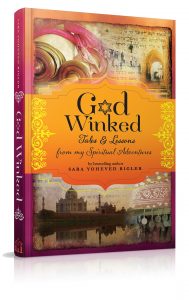 G-d Winked: Tales and Lessons from My Spiritual Adventures
G-d Winked: Tales and Lessons from My Spiritual Adventures
About seven years ago my husband’s stepmother gave my daughter a copy of Sara Yocheved Rigler’s G-d Winked. My daughter, a young teenager at the time had zero interest in Rigler’s spiritual quest and the book ended up on my nightstand. I was fully expecting this memoir to be just another version of the classic “non-religious-Jew-becomes-observant” genre, but there was one chapter, one concept, that spoke to me, so personally and so intimately that I folded that page in the book and kept it on my nightstand for months so I could keep rereading that paragraph.
About a third into the book Rigler challenges you to ask yourself, “What’s my mission?” Or phrased in the frum vernacular, “What’s my tachlis in life?” This is the line that hooked me in and literally changed my perspective on just about everything at a difficult and pivotal point in my life. “Clarity about your mission dissipates guilt for all the worthy endeavors you’re not engaged in” (p. 135). She then gives a personal example, explaining that her mission in life is to reach people, to connect to people via her writing and lecturing, and this knowledge absolved her from the guilt she felt about not liking to cook for myriads of Shabbat guests. While this statement might seem simplistic, almost intuitive, but it was this very specific example (a type of chesed that was logistically difficult for me) that made me realize that I can’t do everything, I can’t be everything, and more importantly, I don’t have to.
As I flipped through the book the other day to find the quote I referenced above, I realized that Rigler had written a personal note addressed to Leah Sara. I had not realized that this book was from my stepmother-in- law’s personal library, although I did remember that she knew the author. Clearly it is no coincidence that a week before the first yahrtzeit of Leah Sara Miller, a”h, Hashem put her book into my hands once again. Truly, God winks.
Chani Miller, OD, is an optometrist in private practice and lives in Highland Park, New Jersey, with her family.
The late Rav Pinchas Hirschprung’s name evokes many important life accomplishments. Leading student of Rav Meir Shapiro, the famous rosh yeshivah who initiated the idea of Daf Yomi. Chief rabbi and builder of Montreal Jewry. Master of all Torah literature, who knew virtually every page of the Talmud by heart.
But I know Rav Hirschprung primarily for the episodes that transpired throughout two years of his illustrious life. (The book covers the period he was in Europe during the war until he escaped to Shanghai.)
In 1939, as the young rabbi of Dukla, a peaceful, mostly Jewish small town in southeastern Poland, Rav Hirschprung quickly found himself in the throes of World War II. His memoir The Vale of Tears begins as a retelling how his family and community experienced the quickly intensifying evil of the Nazis. However, the book soon becomes a story not just of his own relentless quest for survival, but one of deep faith—of the courage and devotion that he lives and spreads while fleeing through ten towns across Eastern Europe, including a stretch of time traveling basically barefoot.
Here he is pushing away a Gestapo officer’s revolver from pointing at a Jewish twelve-year-old boy. There he is persuading a Ukranian peasant wagon driver to consider the final reckoning in Heaven in order to deliver Rav Hirschprung to his destination unharmed. He is caught attempting to cross the Polish-Lithuanian border and miraculously released twice—only to try yet again and succeed.
Along the way, the reader meets many other pure-hearted and pious fellow Jews, such as Dukla’s elderly baker whose messages of religious perseverance stay with Rav Hirschprung throughout his travails, and the sage Rav Chaim Ozer Grodzinski, whom Rav Hirschprung revered and met multiple times seeking guidance.
Interestingly, these recollections were penned just three years after the events described took place, first appearing in 1944 as serialized articles in a Canadian Yiddish newspaper, making this one of the earliest Holocaust memoirs in existence. Through the hard work of the Hirschprung family and the generosity of the Azrieli Foundation, The Vale of Tears was first rendered into English in 2016.
Besides its absolutely riveting and sometimes harrowing accounts, this book moved me for the values that Rav Hirschprung embodied even while literally hovering between life and death: the importance of compassion to others, seeing the gifts of God’s blessings in whatever situation one finds oneself, and the strength an observant Jewish life itself can offer even—nay especially—in trying circumstances.
Indeed, the writing is laden with prose from all kinds of Jewish sources, often employed very cleverly. But as much as Rav Hirschprung’s prodigious mind shines through his chronicles, it is the magnificence of his humanity and heart that make his story one I find so uplifting.
Binyamin Ehrenkranz is a member of the Jewish Action Editorial Committee.
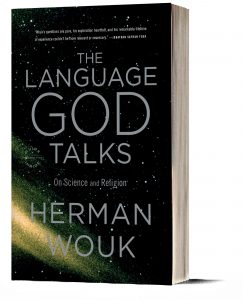 The Language that God Talks: On Science and Religion
The Language that God Talks: On Science and Religion
A book that changed my life was Herman Wouk’s The Language that God Talks. His earlier seminal work, This Is My God, provided a modern-day rationale for the laws of kashrut and the like while people like me who grew up in Orthodoxy find other ways to cleave to the mitzvot. This book, while less popular, addresses more profound issues confronting the Jewish faith: how does an observant Jew square current scientifically accepted ideas in physics, astronomy and cosmology with a literal reading of the Torah regarding the story of Creation and the age of the universe?
As an educated person, this conundrum bothered me. On the one hand, Judaism teaches us to live by facts. In the Talmud, a dispute on halachah at times gets resolved when an Amora declares the custom he saw in the house of Rebbe or Hillel or Rabban Gamliel. On the other hand, what do we make of the Seven Days the Torah mentions and the 5,780 years from Creation as we recite in many contexts?
Herman Wouk took on the issue, framing it as a debate between himself and Dr. Richard Feynman, a prize-winning physicist who served on the commission investigating the 1986 Challenger explosion. In the book, Dr. Feynman, the atheist, and Wouk, the Talmudic scholar, offer their points of view.
The main lesson I learned from the book was that faith encompasses more than reading a dry text. On the topic of Creation, Wouk emphasizes mathematics as key, convincing me that one must embrace science as well. That brought me back to the principles of Kabbalah, which revolve around mathematical formulas. One can fit these formulas into the words of the Torah. This led me to read a book that explained the Big Bang Theory as the meaning behind “And There Was Light.” The Days of Creation can mean eras, making sense of archaeology and biology.
In short, Herman Wouk’s book helped me embrace my faith as showing it to be more than dogma and actually resting on facts, as I had always hoped. As I wrote him in a fan letter, I wished my yeshivah had taught it to me that way. But better late than never.
Joshua Z. Rokach is a retired appellate attorney and a member of the Young Israel of Greater Washington. He lives in Silver Spring, Maryland.
“Reuven, listen to me. The Talmud says that a person should do two things for himself. One is to acquire a teacher. Do you remember the other?”
“Choose a friend,” I said . . .
“Reuven, if you can, make Danny Saunders your friend.”
(The Chosen, p. 74)
When I was a teenager, I discovered the novel The Chosen by Chaim Potok on my parents’ bookshelf. This book transformed me and had a powerful impact on the development of my Jewish identity.
The story begins in 1944 in Brooklyn. Two teenagers, Reuven Malter and Danny Saunders, are brought together when Danny deliberately pitches a baseball at Reuven’s head and Reuven ends up in the hospital. This is an inauspicious beginning to what develops into a deep and enduring friendship between boys from very different backgrounds: Reuven, the son of a Modern Orthodox yeshivah Talmud teacher and Danny, the brilliant heir to his father’s Chassidic dynasty.
It is also a story about fathers and sons. Reuven and his father, David Malter, share a close relationship and discuss everything. Danny’s father, Reb Saunders, only communicates with his son when they study Talmud together. He is raising his son in silence.
This coming-of-age story introduced me to the tumultuous world of the Jews of Brooklyn living during World War II and their crisis of faith after the Holocaust. It was also my first glimpse into the holy life of a Chassidic community. Through Reb Saunders, I began to understand the desperate struggle of the Chassidim to maintain their beliefs and traditions in the face of modernity, and through David Malter, I learned about the fervent dedication of the Zionists to establishing a Jewish state.
How do you live as a Jew in the modern world? What is a true friend? Can you befriend someone from a different background? Can silence be a force for good? Can you pursue a different path from your parents but keep their love?
Grappling with these questions pushed me to grow both as a Jew and as a human being. Reading about the painful struggles of the Jews in the mid-twentieth century strengthened my connection with our people. And the unlikely bond between Danny and Reuven became an unforgettable model of a friendship that could survive even the most difficult of challenges. In all of these ways, this remarkable story, full of wisdom and compassion, changed my life.
Janine Muller Sherr is a freelance writer and former Judaic studies teacher. She currently lives in New York with her family.
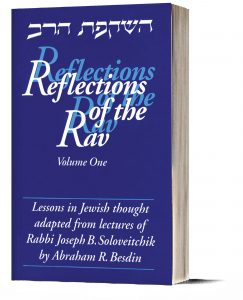 Reflections of the Rav: Lessons in Jewish Thought Adapted from the Lectures of Rabbi Joseph B. Soloveitchik
Reflections of the Rav: Lessons in Jewish Thought Adapted from the Lectures of Rabbi Joseph B. Soloveitchik
I responded deeply to Rabbi Abraham Besdin’s adaptation of some key teachings of Rav Joseph B. Soloveitchik in Reflections of the Rav: Lessons in Jewish thought adapted from the Lectures of Rabbi Joseph B. Soloveitchik. The book summarizes a number of Rav Soloveitchik’s speeches that address key theological questions with his characteristic profound Torah knowledge and penetrating emotional insight. Many of the major themes of his philosophical life appear in this book, in homiletical—and therefore accessible—form. These include religious morality, prayer, the Holocaust, autonomy and the need for organized religion. Rav Soloveitchik emphasizes the need to approach God using our intellect while humbly recognizing our human limitations and ultimately surrendering to God’s wisdom and command. Faith in our tradition and its bearers emerges as an essential ingredient in forging our own path. In this relatively easy-to-read book, seemingly contradictory attitudes are balanced, subtly teaching by example how to lead a vibrant intellectual life of faith. I found the book an entry to Rav Soloveitchik’s thought and a guide to a faithful and intellectually fulfilling Jewish life.
Rabbi Gil Student is Jewish Action’s book editor.
When I think back to my childhood, reading What the Moon Brought written by Sadie Rose Weilerstein and illustrated by Mathilda Keeler is one of those memories that glows brightly. I am sure I read many, many other books back when I was eight (or was it seven?). But for some reason, it’s this book that I remember so well.
I pulled it back off the shelf recently and turned to its copyright page— 1942, by the Jewish Publication Society of America. That’s pretty old by American standards. And its thick brown cover made it feel old to me, reading it as I did in the late 1970s.
But it didn’t feel old in a raggedy, trashcan way, more like in an antique way, like a book of gravitas; it felt authentic. To my eight-year-old self, it felt like Torah.
Its pages told sixteen stories of two sisters, Ruth and Debby, who celebrated the Jewish holidays through the year. They dipped the apple in honey, they built a sukkah, they dressed up for Purim. And since it was written in 1942, they collected pennies to buy a tree in “Palestine” on Tu B’Shevat. (It was 1942; no Yom Ha’atzmaut just yet.)
They did it all alongside parents who looked oh-so sophisticated. Father had a fashionable 1940s fedora and Mother, a sleek polished hairstyle. And Ruth and Debby, one blonde, one brunette, looked like two little Shirley Temples, always with ribbons in their curly hair.
What makes me remember this book so well? Paging through it now, I think it’s because as old as it felt, it felt modern to me too. The characters didn’t look like Tevye and Golda from the shtetl. They looked like . . . well, American. Two little girls, American just like me, who celebrated Jewish holidays, just like I did.
I saw myself on those pages. And it made me feel important—that Jewish experiences just like mine and little Jewish girls just like me were significant enough to be recorded in a book.
No wonder I remember it so well.
Ann D. Koffsky is the author and illustrator of the Kayla and Kugel series, a newer set of stories about a girl who celebrates the chagim. Like Ruth and Debby, Kayla also wears ribbons in her curly hair. Koffsky lives in Long Island, New York, with her family.
This Is My God was not my first encounter with Herman Wouk’s work. I’d watched the film versions of Marjorie Morningstar and The Caine Mutiny on television sometime in the late 1960s/early 1970s, and I was intrigued enough to borrow the books from my local library on which they had been based. They were both entertaining reads. A year or so later, The Winds of War was published and rocketed to the top of the best-seller lists. When reading the reviews of that book I kept seeing references to “Mr. Wouk, an Orthodox Jew,” which I found very surprising. None of the Orthodox Jews I knew wrote novels, much less best-sellers that had been made into movies with Gene Kelly and Humphrey Bogart. I saw a reference to This Is My God in one of the reviews, and so I borrowed it from the library, too.
I was in my early teens at the time, and the book just blew me away. I already knew back then that the professional path I was going to travel would be a bit different than those to be taken by my Bais Yaakov classmates. I loved books—reading them, writing about them, talking about them—and I was fascinated by how they came into being and by the world of book publishing. And now here was an Orthodox man who had written this extraordinary guide to Torah Judaism (only much later did I become aware that in 1959 it, too, had been a New York Times best-seller) and who was also succeeding in the very world I had been dreaming about.
Until works by such scholars as Rabbi Hayim Donin, Rabbi Jonathan Sacks, Rabbi Adin Steinsaltz, and Rabbi Joseph Telushkin came along, This Is My God was the treasured companion for a young woman who wanted not only to live her faith but also to explain to friends and colleagues who couldn’t be farther away from it the joy and meaning it gave her.
So I bought a paperback edition of This Is My God and kept it as a sort of talisman as I went off to college and then tried to find my way in publishing. But as I began to interact with people outside of my frum world, it became more than a talisman; it became a guidebook. I didn’t think there was anything particularly interesting about how I lived my life, but my fellow English majors in the Brooklyn College Scholar’s Program were fascinated by the world I came from. And they would ask me pretty detailed questions about Orthodox Jewish observance, rituals, and customs—not because they were trying to catch me out, but because they genuinely wanted to know. This, of course, was exactly what Wouk wrote about in This Is My God, and as I came up with my carefully crafted responses I would consult my copy of the book to see how Wouk had phrased it. This only intensified when I started working in publishing, as an editorial assistant at The Viking Press. I wanted to hear from our Viking editors what it had been like to work with Saul Bellow and Jack Kerouac; they wanted to know why the winter solstice occurs after the Friday with the earliest licht bentchen. And if a married women is allowed to wear a sheitel made out of her own hair. I didn’t expect to find answers to those questions in This Is My God (that’s what my rav is for), but I did find in it brilliant articulations of what I believe and why I believe it, which I would reference in conversations with my colleagues on many occasions.
I reread the book to write this essay, and I was pleased by how well it has stood the test of time. Yes, it is dated in spots—at that point in his life Wouk didn’t seem to think that girls had a serious interest in Torah learning, and although he wrote eloquently about the value of Jewish education, he seemed a bit uncertain about the yeshivah day school movement. But until works by such scholars as Rabbi Hayim Donin, Rabbi Jonathan Sacks, Rabbi Adin Steinsaltz, and Rabbi Joseph Telushkin came along, This Is My God was the treasured companion for a young woman who wanted not only to live her faith but also to explain to friends and colleagues who couldn’t be farther away from it the joy and meaning it gave her.
Altie Karper is the editorial director of Schocken Books, a division of Penguin Random House LLC.
I have been Orthodox from birth, although we did some things that were not right. We kept a kosher home and went to shul on Shabbat and yamim tovim; my father would have gone daily if he wasn’t working. However, we did turn on lights on Shabbat and despite the lack of an eruv, I did carry the newspaper home on Shabbat, although we did not pay for it.
I was actually happy with the way we practiced Judaism except that I always felt that it was unfair that my friends went to the beach or the movies on Saturdays and I couldn’t go.
Then I read This Is My God by Herman Wouk and realized that Shabbat had a positive aspect to it. I may have still felt like I was missing something, but I began to focus on the positive. Although I was still a teenager, when I read that it was great to have twenty-four hours when no one could bother you about anything, I realized that Wouk was right.
Later on, when I was in boot camp in the army, I got off every Saturday while all the rest of the company was out drilling. My job was to wait for the inspecting officer to inspect our barracks and remember all the demerits he gave our platoon for a messy bed or things like that. One Saturday, I was sitting on the steps outside my barracks waiting for the officer when the sergeant of the neighboring platoon called out, “Horowitz, don’t you feel guilty about sitting around while your buddies are out drilling?” I laughed and said, “When I was a kid all my friends were going to the beach and the movies while I had to stay home and do nothing. Now I’m finally getting even!” And that’s when I remembered what Herman Wouk had taught me.
I have met many irreligious Jews in the process of doing teshuvah and they asked me for book recommendations. I always recommend This Is My God.
Anonymous
More in this Section:
Raising a Generation of Readers by Steve Lipman
Turning a Page in the World of Jewish Bookselling by Sandy Eller

